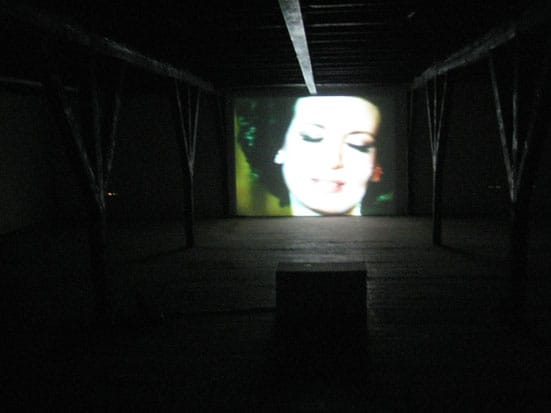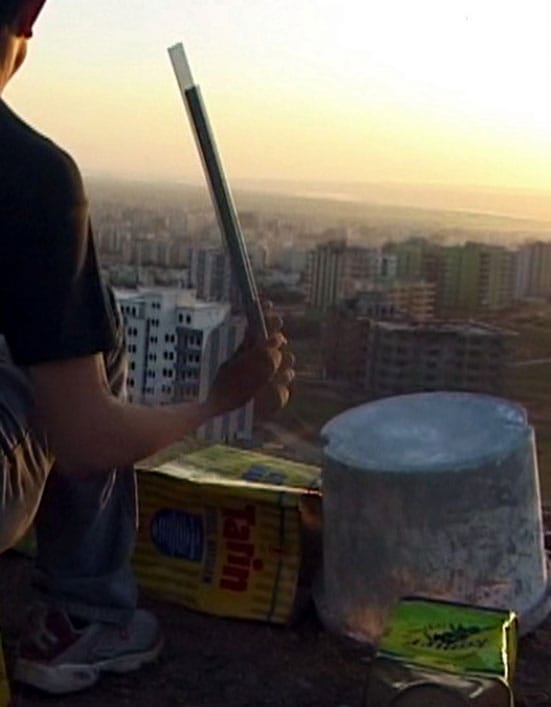Dear Artvehicle,
Istanbul is one of my favourite cities in the world so I was going to
have a brilliant time, whatever the 10th biennial was like.
The excellent 9th Biennial was always going to be very hard to live up
to. This year's curator is Hou Hanru who drew the backdrop of the
exhibition: 'We are living in a time of global wars.' True. The three
main venues were Atatürk Kultur Merkezi (AKM), Istanbul
Manifaturacilar Carsisi (ICM) and Antrepo No. 3.
At Antrepo, a warehouse by the Bosphorus, the show was subtitled
'Entre-polis' and contained some strong works, sometimes badly
installed. One of the high points was Rainer Ganahl's 'Silenced
Voices: Bicycling Istanbul's Topography of 21 Murdered Journalists'.
Ganahl wrote the names of journalists in chalk at the sites where they
were murdered in the city. He was stopped by the police on one
occasion, only escaping by pleading 'biennial'. Apparently Turkey is
the eighth most dangerous place in the world to be a journalist.
Turkish collective Extrastruggle asked visitors to fill in posters
with 'How... is he who calls himself an Armenian/ Kurd' in mockery of
Ataturk's famous declaration 'How happy is he who calls himself a
Turk'.
Another highlight was Michael Rakowitz's recreation of objects looted
from the Baghdad Museum after the fall of the city in 2003, using
packaging from Middle Eastern food. They are labelled with quotations
from the time, from Donald Rumsfeld's glib 'freedom's untidy' to
dismayed museum experts assessing how some 10,000 years of human
history have been destroyed. The room reverberated incongruously to
the sound of Deep Purple's 'Smoke on the Water' because the museum
director Dr Donny George, who strikes a heroic figure in his quest to
return the looted objects, plays the song in a cover band.
Ivan Grubanov's pen and ink drawings of his former president Milosevic
on trial in The Hague, drawn over two years sitting in on the case,
are shown on twin slide projectors. These ephemeral, banal renderings
of this evil man question the reality of international justice.
Fikret Atay's 'Tinica' is projected large, a boy sets up a drum kit
made of old cans above the city of Batman, the artist's home town on
the border of Turkey and Iraq. After a virtuosos performance the boy
suddenly kicks the improvised drums over the edge into the sunset in a
rock and roll finale.
The show at AKM is called 'Burn it or not?', referring to the fate of
this elegant Modernist concert hall on Taksim Square which currently
hangs in the balance. AKM is threatened by the gentrifying forces of
'neo-liberal economic power, hand in hand with populist political
power' who apparently wish to replace it with a post-modern corporate
complex. The works in this space deal largely with similar issues,
there are multiple photographs of bland interiors; a film about
cleaning the glass on the Reichstag. The notable exception is Xu
Zhen's glass case containing the tip of Everest and a cluster of tents
that work well in their austere surroundings.
IMC (Textile Trader's Market) is an inspired venue, a huge complex of
shopping units and workshops outside the tourist map of the city. This
Modernist bazaar is also under threat from 'gentrifying capitalist
forces'. While searching for the units housing exhibits you pass
through stores selling carpets, wheelchairs, bean bags and endless
sewing machines, a reminder of the sweatshops and factories in the
city. Many of the units are empty and the place feels underused. There
were some interesting works in this part of the exhibition, well-tuned
to their surroundings, but it was practically impossible to view them
comfortably. The space was too cramped with nowhere to sit for whole
programmes of video works, and lux level issues had only been solved
in a very temporary way. I watched some interesting documentary-style
works about sex workers and sweat shop employees and read Julien
Previeux's cheeky letters of 'non-application' to various unscrupulous
employers. The highlight was Chinese artist Chen Chieh-jen who was
'pirating his own work', circulating copies of his much admired films
using pirate vendors asking for a small donations, to be given to
charity. Considering how precious most artists are about access to
copies of their films, this felt radical.
Santral Istanbul, a new steel and concrete art venue in a former
electricity factory, houses 'Modern and Beyond' a history of Turkish
art over the last century. The first half is derivative Modern
painting, such as Cubist renderings of Turkish subjects done forty
years after the event, but the second half offers a fascinating and
important survey of Turkish contemporary art, through conceptual art,
installation, feminism and film. It showcased amongst others, Halil
Altindere Esra Ersen and Serkan Özkaya. Meanwhile, Istanbul Modern
showed a celebration of the last 20 years of the Istanbul Biennial;
'Time Present, Time Past'.
Sylvia Kouvali's new gallery RODEO has just opened in the Tütün
Desposu (Tobacco Warehouse) in Tophane, the wooden building used in
the last biennial. Kouvali has some excellent artists, a superb space
and the show was thoughtfully and immaculately installed, a relief
after the surrounding biennial. Ahmet Ögüt has filled the ground floor
room with asphalt. A beautiful wall collage by Hüseyin B. Alptekin is
assembled from his ongoing archive of objects from the journey of his
life. Mustafa Hulusi's op-art 'Expander' poster, familiar from the
streets of London, finds itself on the wall of a gallery. Gülsün
Karamustafa presents archive photographs from 1954 when icebergs from
the Black Sea entered the Bosphorous and stopped shipping traffic.
The pictures show scenes of people happily hopping across the icebergs
to commute to work. Eftihis Patsourakis has covered the gallery
windows with colourful, abstract cubic patterns that resemble stained
glass but turn out to be post-it notes. While Panayiotou's riddling
mixed media installation evokes the Wizard of Oz, weather phenomena
and death with its embracing skeletons. The attic is haunted by the
face of an Egyptian soap star in Haris Epaminonda's tense and poignant
film 'Tarahi II'. Kouvali is also responsible for the impressive YAMA,
video screenings on a giant advertising screen atop the Marmara Pera
Hotel, best viewed from the roof terrace bar of the Londra Hotel with
a gin and tonic.
Haluk Akakce has a slick solo show at Galerist including video works
and mirror wall pieces, as well as featuring in the Istanbul Modern
and Santral shows. Galerist also sponsored 'Sobe!' a show of women
artists curated by Leyla Gediz at Bilsar Binasi. Downstairs from
Galerist is URA!, featuring the Slayer Pavilion, a Gregor Schneider
inspired look into the world of a Goth-metal teenage boy. They also
presented a lively gig at Dogztar featuring Selfish Cunt, No Bra and
Blurt. Across the road, outside Platform Garanti, a frog jumps up and
down croaking 'Great Show'. London-based artist Harold Offeh presented
his Mammy project in 'Hybrid Narratives' at Akbank Sanat. And
London-based curator Nazli Gurlek co-presented a collaborative
international show at Mimar Sinan University of Fine Arts. Look out
for Alti Ayik reopening in a new space in November.
All this art should be punctuated by drinks on elegant roof tops,
coffee in trendy Tünel and meze in vibrant Nevizade Sokuk. Listen to
the call to prayer while marvelling at once beautiful houses now
derelict and inhabited by plants and stray cats. See the sights of the
city, take a boat to the islands. Just don't ever rely on a taxi
driver knowing where you want to go.
AM

Haris Epaminonda
Tarahi II, 2006
Video 3:40
Courtesy of RODEO

Fikret Atay
Tinica, 2004
Video transferred to DVD 7:32
Courtesy of the artist and Chantel Crousel